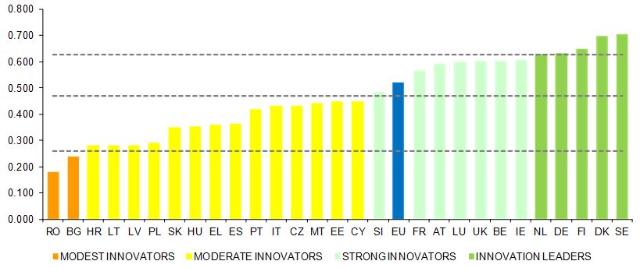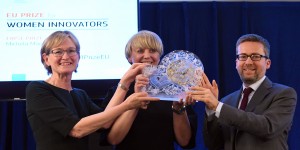Today the Commission released the 2016 results of the European Innovation Scoreboard, the Regional Innovation Scoreboard and the Innobarometer.
The main findings are that EU innovation is catching up with Japan and the US, Sweden is once again the innovation leader, and Latvia has become the fastest growing innovator.
European Innovation Scoreboard 2016 country ranking
(axis Y – Summary Innovation Index, axis X – EU countries)
Elżbieta Bieńkowska, Commissioner for the Internal Market, Industry, Entrepreneurship and SMEs, said: “I want Europe to be a place where innovative SMEs and start-ups flourish and scale up within the Single Market. This requires a concerted effort. At EU level, we need to simplify VAT regulation, adapt insolvency rules, make information on regulatory requirements more easily accessible and work on a clear and SME-friendly intellectual property framework. We also need to keep adapting the Single Market to ensure that innovative services such as the collaborative economy find their place”.
Carlos Moedas, Commissioner for Research, Science and Innovation, said: “Leading countries and regions are supporting innovation across a wide range of policies from investment to education, from flexible labour conditions to ensuring public administrations that value entrepreneurship and innovation. The Commission is doing its part by promoting innovation across policy areas too. Not only that, we’re also improving access to private finance through the €315 billion Investment Plan for Europe and the Capital Markets Union, as well as creating a new European Innovation Council”.
Corina Crețu, Commissioner for Regional Policy, said: “Smart specialisation strategies help Member States and regions capitalise on their competitive assets in Research & Innovation and find opportunities for cooperation between business and academia. As such, they are compasses for innovative, long-term investments supported by ESI Funds and, when possible, other EU sources of finance. This contributes greatly to Europe’s shift towards a knowledge-based economy”.
The main findings of the three reports published today are:
- Sweden is once more the EU innovation leader, followed by Denmark, Finland, Germany and the Netherlands.
- In selected areas of innovation, the EU leaders are: Sweden – human resources and quality of academic research; Finland – financial framework conditions; Germany – private investment in innovation; Belgium – innovation networks and collaboration; and Ireland – innovation in small and medium-sized companies.
- The fastest growing innovators are Latvia, Malta, Lithuania, the Netherlands and the UK.
- Regional innovative hubs exist also in moderate innovator countries: Piemonte and Friuli-Venezia Giulia in Italy, País Vasco in Spain and Bratislavský kraj in Slovakia.
- Overall, the key driver of becoming an innovation leader is to adopt a balanced innovation system which combines an appropriate level of public and private investment, effective innovation partnerships among companies and with academia, as well as a strong educational basis and excellent research. The economic impact of innovation needs to manifest itself in terms of sales and exports of innovative products as well as in employment.
- Specialisation in Key Enabling Technologies (KETs) increases regional innovation performance, in particular in advanced materials, industrial biotechnology, photonics, and advanced manufacturing technologies.
- Over the next two years the EU’s innovation performance is expected to improve. A majority of companies plan to maintain or increase the level of investment in innovation over the next year. Businesses in Romania, Malta and Ireland are the most likely to increase their investment in innovation next year.
Background
A recent report ‘Science, research and innovation performance of the EU’ establishes a clear link between growth in the EU and investment in research and innovation, underlining the importance of continued efforts to increase investment in the area. For information on the Commission’s actions to support innovation, please refer to the last section of our FAQs.
The annual European Innovation Scoreboard provides a comparative assessment of the research and innovation performance of the EU countries and selected third countries. The 2016 report includes, for the first time, a forward-looking section focused on recent developments, trends, and expected changes.
The Regional Innovation Scoreboard is a regional extension of the European Innovation Scoreboard, assessing the innovation performance of European regions.
The Innobarometer reveals recent trends and attitudes in businesses’ innovation-related activities in the EU countries as well as in Switzerland and the US.
More information:




